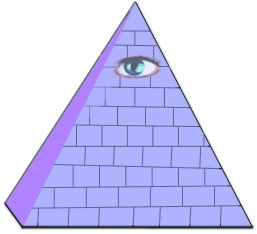Ancient Egyptian Calendar
Clark Nelson
1921 wds
URL: http://www.timeemits.com/AoA_Articles/Ancient_Egyptian_Calendar-gr.htm
Ancient Egyptian Calendar
The ancient Egyptians were doing something special with their calendar system. They had computed and used the 365-day-solar-year. Ancient Egyptians had also accounted for the one-quarter-leap-day fraction every year. The Egyptian Calendar was decidedly solar. Egyptian starting calendar dates between 4,236 B.C.E. and 4,241 B.C.E. are derived from hieroglyphs, Egyptology concerning Pharaoh Dynasties, and a few Greek writings. Using 12-lunar-months of 30-days each, the official Egyptian year had 360-days. Another five special feast days were added to 360-days at the end of the year following the winter solstice. The quarter leap day every year was accumulated.
A 365-day Egyptian total year was
matched with a 365-year period. Instead
of including a single leap day at the end of every four years like we do now,
the Egyptians added a single year at the end of 4 passes of 365-years each
(Eqn. 10). After 1,460-years, or 4
periods of 365-years, one full year of leap time figured to be
365-extra-leap-days. One leap day every
4-years of our calendar was reversed for one complete year in the Egyptian
Calendar. The ancient Sothic Cycle of
the Egyptians at the top layer of the pyramid in figure 5 had 1,461-years. The top-level summit of the pyramid shown
indicates the 1,461-year-Sothic-Cycle of the Egyptians. The identical treatment of days and years was
the paramount feature of the Egyptian solar calendar.
1,461-Year Sothic Cycle
Equation
13.
10. 1,461-Year
Sothic Cycle
= 4 Cycles x 365 Years per Cycle
x 365.25
Days per Year
= 1460 Years x 365.25 Days per Year
= 1460 Years
x (365
Days per Year + 0.25 Days per Year)
= 1460 Years (365 Days per Year) +
365 Days
= 1460 Years + 1 Year
= 1461 Year Sothic Cycle
Numerical matching of days and
years is discovered in the pattern of the ancient Egyptian Calendar. Our modern leap day on February 29 is
intercalated every 4 years of 365-days each, or after 1,460-days. The Egyptians reversed this practice to
intercalate an entire "leap year" after four complete passes of
365-years, or 1,460-years. The final
leap year added 365-leap-days more to make the whole Sothic Cycle 1,461-years
long. The Egyptian dynastic rule of the
pharaohs, the heavenly observation of the star Sirius, and the resulting theism
were perpetuated by the solar calendar.
The Sothic Cycle and the associated Osirian mythology
helps tie the ancient Egyptian Calendar to the Sun Kingdoms’ Calendars. The resurrection story transforming a god
into a star is a fascinating parallel.
Osirus is said to have become Sirius and Quetzalcoatl became Venus. Secondly, we note 1,460 days attached to
Sothic Cycle are doubled in the Mesoamerican legends to be 2,920 days. A finite agreement is achieved from the
Dresden Codex and Egyptology.
The ancient Egyptian Sothic Cycle
above shows the relationship of the Biblical Enoch character and the Egyptian
Calendar sequence. Enoch is the seventh
pre-flood forefather descendant from Adam.
Enoch's ages are associated with calendars and astronomy. Our Holy
Bible includes written records that began in the extreme past. Before the flood, ties existed between the
group of characters called the Antediluvian Patriarchs in Genesis, Chapter 5, and the early calendars.
Genesis
"And all the days of Enoch were three
hundred sixty and five years:"
Enoch's age of 365 years in Genesis relates to the Egyptian Sothic Cycle of 1,461 years. Other scriptures such as Hebrews 11:5 in the New Testament also mention Enoch. Extra reading in some very old Jewish writings, namely the three books of Enoch, specify that Enoch assigned 364 days to the calendar year. The Enochian Calendar had 52 even weeks of seven days each, with one day remaining. Traditional Jewish use of the seven-day week is upheld by 52 even weeks. Seven Sabbatic years may have been included to follow the Jubilee pattern. Seven days and the composite seven years maintain the Sabbath order. The last day of the solar calendar year was set apart and added up over several years. The Enochian Sect was the group of followers that recognized this idea of cascaded time measurement. Putting this whole picture together, the ancients were using numerical matching of days versus years to measure the same thing, time. The Enochian Calendar closely resembles the ancient Egyptian Calendar.
1461 Year Sothic Cycle of
Ancient
Pyramid Calendar of
Enoch
1461 Days – Years
364-Years of 364-Days per Year 5 Special Days Each Year 364-Years of 364-Days per Year 5 Special Days Each Year 

1461 Year Sothic Cycle Figure 6
1461 Year Sothic Cycle of
Ancient
Pyramid Calendar of Enoch
1461 Year Sothic
Cycle = 1460 Years + 1 Year
1456 Years + 4
Years + 1 Year of Leap Days
Four Sides = 1456
Years + 364 Leap Days)
Four Sides = 4(364
Years + 91 Leap Days)
1461 Days = 1456
Days + 4 Days + 1 Leap Day
Four Sides = 4(364
Days + 1.25 Days)
Four Sides = 4 X
365 Days + 1 Leap Days
1456 Years of 364
Days per Year
Solar Year =
365.25 Days
Solar Year = 364
Days + 1.25 Days per Year
364 Years of 364
Days per Year
Ancient time reckoning and
recording affirmed the most basic counting procedures according to cycles of
the sun, moon, and stars. Entrenched
throughout the history of world civilization are the main ingredients of
lunar/solar calendars. From the earliest
conceptions of Adam and Eve to the wide array of mythology and folklore,
humanity is aligned with masculine and feminine dualism inherent to lunar/solar
calendar operations. Patterns of female
fertility cycles have been forever linked with lunar, monthly periods of about
29-and-one-half days. Literal Hebrew
meanings found in Bible
dictionaries, lexicons, and the more exhaustive concordances provide Eve to be
the "woman, child-bearer, and mother to all the living." Adam meant the "generic man, breathing
creature", or simply "person" in literal Hebrew.
Lunar/solar time splits were
expanded results of dual heavenly observance.
Nearly 11-days of lunar/solar separation time came between, divided, and
separated the lunar year of 12-moon-months, or 354-days, versus a solar year of
365-days. Time was further subdivided,
or split, to attribute half the difference to the lunar, female Eve side of
ancient calendars. The remaining
companion half of 11-days was attributed to the solar, male side of time
reckoning.
The early portion of Genesis
accommodates both 19-year and 20-year types of l/s cycles. The Jewish Calendar
conveys the bulk of calendar reference.
The ancient Egyptian Calendar has to be regarded as a supplemental
source. Connections between the Egyptian
Calendar and the Sun Kingdoms’ Calendars can be further explored. The intent of the scriptures carries
historical calendar information and the spiritual aspects devoted to worship.
The Bible is the authority we use to validate this form of calendar science. All the calendar knowledge that we can possibly assess relies upon the antiquity of the text. Our study of time next crosses a threshold of spirit and faith to admit understanding the original purpose. The spirit of the archaic writings leads us to intention and context. Faith must take precedence over factual indicators.
Testimony is the evidence of things
unseen. The Jewish God has no form or flesh.
The Jewish Calendars is an instrument that positions feasts and
festivals for practical living. Like
Ancient writers of the Old Testament recorded the passage of time with the same thesis of testimony. The prudent approach is to decipher meanings with similar intention and context. The spirit and essence of the original scriptures can be captured with the aid of calendar tools. The goal is to view the calendar as the ancients once described. Inventory of the calendar tools include calendar fragments, ideas of faith, and testimony.
Time measured by the earliest calendar lengthened along with supporting philosophies toward the heavens. Another layer of dualistic observance was added when the next graduation of the calendar occurred. To the feminine, Eve side of the lunar/solar calendar again was attributed half the difference between lunar and solar calendar expansions. The masculine, solar sun-side counterpart received half the difference between the two systems also. The miracle of human birth was addressed by the calendar eons ago.
Any 19-year cycle in the Jewish calendar multiplies 11-days of lunar/solar difference for about 209-days. Ancient Greek, Babylonian, and Chinese calendars incorporated similar 19-year patterns that added some 209-intercalary days in order to adjust the lunar side with the solar side of the calendar. Sister calendars of the Aztec, Inca, and Mayan cultures also used lunar/solar calendar systems for measuring time. The 19-year l/s time split pattern is a calendar tool.
The 20-year l/s cycle modifies the
19-year l/s calendar tool. Following
other l/s calendars, 209-days of lunar/solar separation were approximated for
210-days, or seven extra intercalary months of 30-days each. Within Mesoamerican calendars, a 20-year
period became the standard unit.
Numerical matching of seven intercalary months in 20-years reinforced
the sacred seven-day week that was found especially in 19-year lunar/solar calendars. Along these lines, numerical matching for
given multiples of days was associated with numerical matching for the same
number of years. Numerical matching of
days and years becomes an imperative calendar tool.
Calendar science provides an accurate view of history. The calendar is the foundation that history is built upon. Chronology of the past is necessary for cultural study. Remote history preserves important dates to explain things in the past. Anniversaries and holidays are significant. Celebrating these important dates shapes the future. Every society uses a system of time measurement to assign dates to events. Today, the modern calendar is highly developed. An improved acquaintance with the Old Testament is obtained through important calendar information.
Ancient calendars of the
The Bible calendar advocates literal Hebrew definitions for Adam and Eve. Biblical ages given for Adam, and the Antediluvian Patriarchs following, include both primary and secondary age levels. Time measured from birth of the named father until begetting the next character is the primary age. Primary ages listed serve lunar/solar divisions that are halved in order to develop the extensive calendar. Secondary ages comprise the time measured from birth of the next son until the death of the father. Secondary ages involve overall cycles that relate to a distinctive intercalary time. Halving and doubling of time was the main style of recording ancient lunar/solar calendars. Seven-day week divisions were set by lunar phases during the calendar of Adam. Rounded 30-day months provided formative lunar calendars. Early religious philosophies and calendar use are documented with a parallel theme in the Book of Genesis
Are you a pastor, educator or a student of the Holy Bible? Timeemits.com seeks anointed people to review and contribute to the Ages of Adam ministry. Ancient lunar/solar calendars like the Jewish and Mayan calendars provide the background to understanding early time. Ancient calendars of the Holy Bible use differences between the moon and sun, numerical matching and a 364-day calendar year to describe X-number of days that match with X-number of years. Ages of Adam is a free read at http://www.timeemits.com.
Clark Nelson is webmaster for www.timeemits.com and author of Ages of Adam and sequel, Holy of Holies. Contact article@timeemits.com for more information. © Copyright 2006 Clark Nelson and timeemits.com All Rights Reserved.